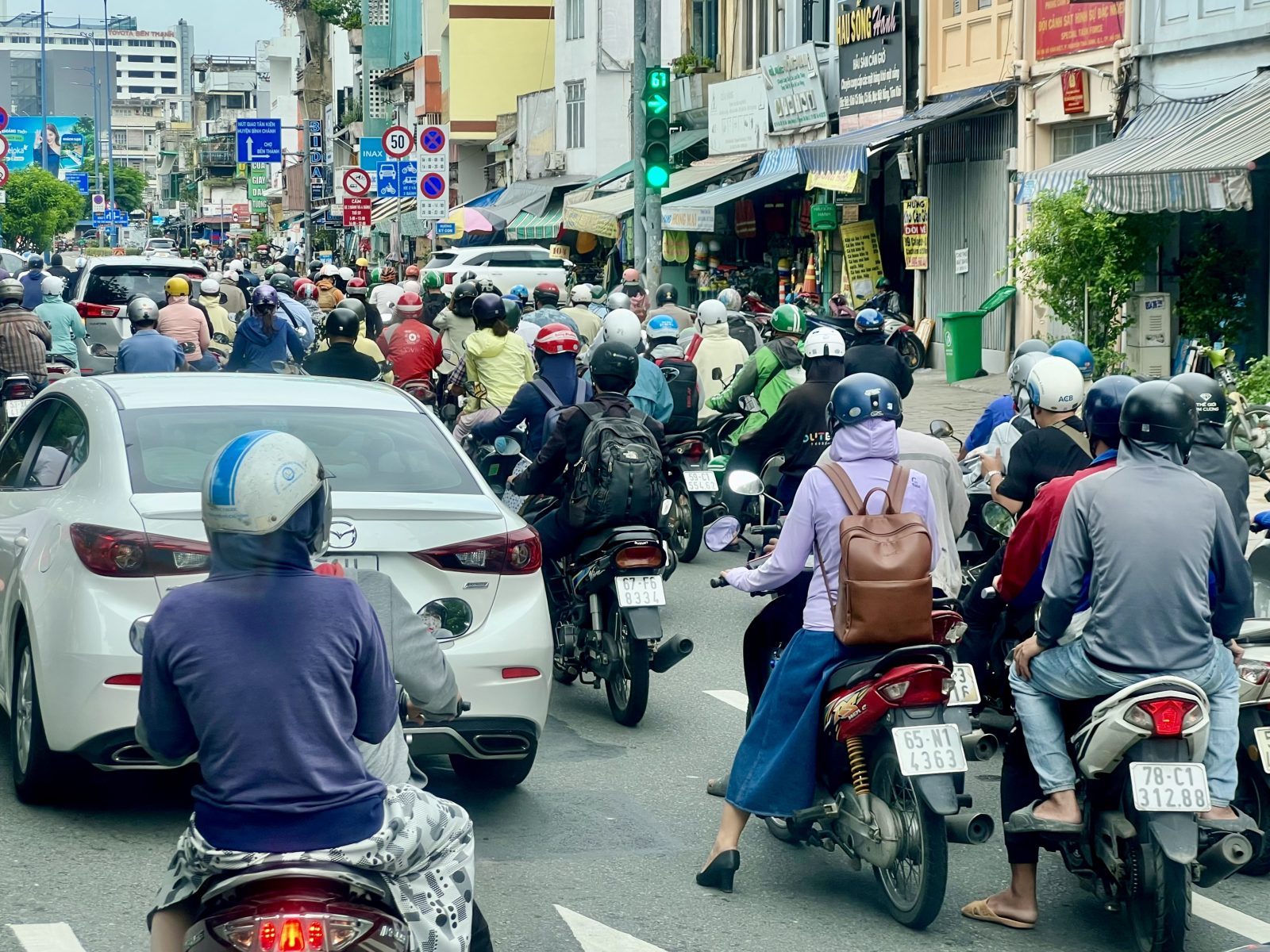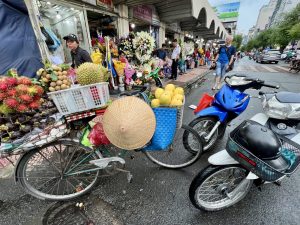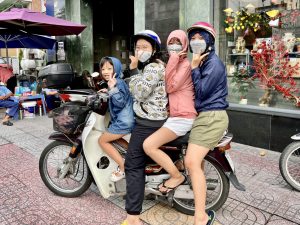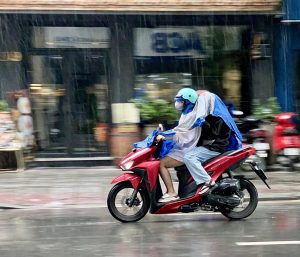Good Warning Vietnam! After four visits to the southeast Asian country, Bruce Linnell has learned a thing or two about riding in Vietnam…
Good Warning Vietnam! This is a country of almost 100 million souls blended from 54 different ethnicities. It is is awash with great foods, clashing colours, opulence, cluttered footpaths, squalor and more than 40 million motorbikes. Those two-wheelers are mostly scooters. They are everywhere.
First time there we’d met a local in Nga Trang who sold us a five-day 9000km guided tour for đ12,000,000 ($A750). It got us a 125cc Honda single to ride two-up, to which we tied three of our four soft bags on behind us while our guide Minh – on a similar Honda – carried the fourth.
Once I’d used my Leatherman to adjust the clutch and brake lever positions, riding was simply a matter of following the leader and taking in the views – like hell! Sometimes after lunch it rains. You stop, don plastic ponchos and ride on. We visited a cashew processing facility, a blacksmiths, a brick-making factory, a cocoa plantation; we saw how pepper was grown and where latex grew to make condoms. We rode across the old north/south border and saw how the areas once denuded by Agent Orange were, at last, arable. The Vietnamese will grow something on just about any piece of ground.

Helmets are compulsory in Vietnam, except not everyone wears one. Some suffice with a head scarf. Others wear war surplus steel lids or a straw coolie hat. Someone said the reason why so few children wear helmets was due to fears of stifling cranium growth. Roadside stalls sell what most choose to wear here, essentially a pudding basin plastic shell with a styrene insert. Visors, peaks and pixie ears are optional. As it was, we’d brought our own lids from home.
Rides are interesting – yet fraught with danger. The thing is, coming from a first-world country where most road users have both appropriate licences and road rules to apply, once you start using Vietnamese roads, not one local seems to have either. I’d travelled with an international licence on my first trip, which had been sufficient for the several other countries I’d visited and ridden motorcycles in, but apparently such will not always be recognised by authorities in Vietnam. That can present a few issues with not just the police.
No. Your travel insurance company may not recognise any accident damage or medical claims either, and it will probably also deny your claim if you don’t disclose your intention to ride a motorcycle at the time of purchasing the policy. So please be aware of this important fact.

Uniformed motorcycle cops are sometimes seen at an intersection, parked on a footpath, watching the traffic (or their phones). Despite witnessing many flagrant abuses of rules on my visits, I have only once seen a rider stopped by them. Apparently, the donation of some “coffee money” can sort most minor infringements here.
The speed limit in urban areas is 50km/h. Out of town it’s 80km/h. We once spotted a speed surveillance unit, but otherwise police seem to ignore most obvious lawbreakers.
Hiring a scooter is easy enough. Usually 24 hours hire will cost đ150,000 ($A9). They’ll insist on payment up front, and they’ll hold on to your passport until the machine is returned. And I’ve never been asked to show a valid motorcycle licence. Interesting.
It’s incumbent on the hirer to refuel the bike. The scooters weren’t always clean. Mostly I’d just check tyres and pressures, chain tension (if it had one), then ease out into the traffic. Here they ride on the right-hand side going forward, yet often they’ll come towards you on your side of the road. So stay alert.

Too often riders come swooping in from the side – no head check or apparent awareness you’re even there. Cars and bikes make sudden u-turns – be buggered any following, or oncoming vehicles… unless they’re bigger. And forget 90-degree turns, the preference is to scribe a diagonal line half a block long to get to the intended corner. Many riders talk and text on their phones, and one friend reported seeing five different scooters down during a two-hour drive.
At traffic lights, a signal counts down seconds before the lights go red or green again. Some riders take off a couple of seconds earlier. Others have already raced up the footpath. Craziest of all though is when the light turns green, the left-turners pull out in front of oncoming traffic.
Both in and out of town, there is always someone about to pass to fill any gap ahead. Clean, well adjusted mirrors are imperative. Pedestrian crossings afford no right of way. Walking across roads requires good timing and unfaltering commitment. Don’t stop.

Most riders wear sandals, few wear gloves. It is common to see four, sometimes five bottoms seated on the one scooter, with usually the youngest child riding in front on a specially constructed seat straddling the step-thru area.
With the chaotic traffic in the big cities like Ho Chi Minh and Hanoi, I have rarely felt confident to do both the navigating and the riding. Instead, I’ve found it preferable to follow someone who knows where we are going so I can be more focused on staying alive.
Apart from a general lack of road courtesy, the Vietnamese are humble and respectful of their elders, which is just as well given there is no social welfare.
But all that aside, Vietnam is a great place to holiday, especially during a cold Australian winter. So try it this year.
Mate’s rates
Markets are the place to go for any supplies. Prices are often negotiable. Depending on the brand, a can of ale costs around $1.30, a packet of 20 cigarettes about the same. Four-star accommodation, with breakfast included, is around $50 a night, and a trip to the dentist between one third and one half what you pay back in Australia.

Beaut scoot
The Saigon Scooter Cafe is run by British scooter enthusiast Pat Joynt and his wife Linh. Scooter themed, the interior is a riot of things scooter and like paraphernalia. There are posters, a World War II paratrooper’s collapsible scooter, other two wheelers, chairs Pat has made from scooter parts, and an undeniable sense that this place venerates all things relating to these two wheeled contraptions.
At his other business, the Saigon Scooter Centre, Pat has a huge collection of motor scooters warehoused and from which he selects machines to restore and resell worldwide. His standards are high. Pat has also developed his own electric scooter brands, his Lambretta Ebretta and Vespa VTronic models each gaining popularity among riders in several countries today.

Whatever, Trevor
Ex-Mount Gambian Trevor Long, pictured above with wife Huong, operates Saigon Motorcycles in Ho Chi Minh City.
With outlets in District 2 and District 7, Trevor both sells and rents bikes and has a heap of gear for sale.
He hires various scooters, while Honda’s CB500X, BMW’s G 310 GS and KTM’s 390 Duke are also available. He leads tours, but those seeking to tour solo can pay an extra $5 a day for Trevor to set an itinerary and provide Google maps describing each day’s route, with recommendations for accommodation and food destinations where
they are applicable.

WORDS + PHOTOGRAPHY BRUCE LINNELL


